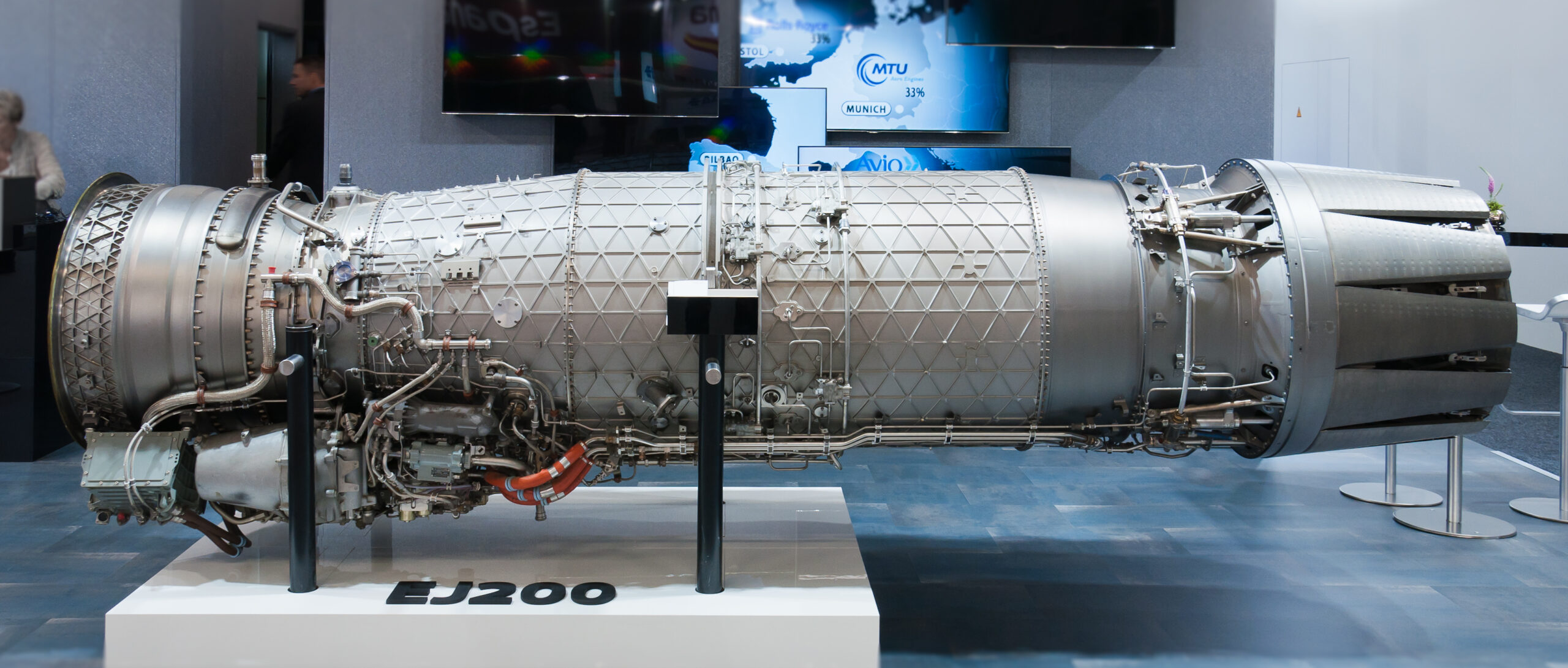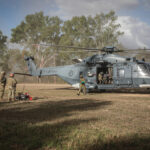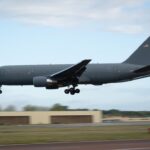EUROJET Turbo GmbH has agreed to deliver up to fifty-four new EJ200 engines for the Italian Air Force’s forthcoming batch of twenty-four Eurofighter Typhoons. Defense officials confirm the deal was signed in Rome with the NATO Eurofighter & Tornado Management Agency (NETMA) acting for the customer. The contract covers engines, spares, digital controls, and an initial logistics support package. According to industry sources, first deliveries will reach Cameri Air Base in 2027, lining up with the airframe production sequence already locked in at Leonardo’s Caselle final-assembly line.
The order follows Italy’s December 2024 decision to replace its oldest Tranche 1 Typhoons. That move freed the way for newer airframes able to integrate next-generation weapons and updated pilot interfaces. Our analysis shows the contract keeps the engine supply chain warm while Europe prepares for the Global Combat Air Programme, planned to fly in the mid-2030s.
EUROJET Partner Plants and Avio Aero’s Final Assembly Role
NETMA General Manager Air Vice Marshal Simon Ellard (ret.) and EUROJET Chief Executive Ralf Breiling signed the paperwork at Palazzo Aeronautica. The document authorizes engine module production at the consortium’s four partner plants:
- Rolls-Royce, United Kingdom
- MTU Aero Engines, Germany
- ITP Aero, Spain
- Avio Aero, Italy
Avio Aero will complete final assembly and acceptance tests at its Rivalta di Torino facility, then ship the engines to Leonardo’s flight-line integration center. Italian industry therefore keeps a dominant share of the value chain, preserving high-skill jobs and sustaining the country’s test-cell infrastructure.
This package includes:
- 54 × EJ200 Series 04 turbofan engines
- Digital engine control units with health-monitoring software
- Tooling, consumables, and spare powerplants equal to 10 percent of the fleet
- Five-year performance-based sustainment option, exercisable in 2026
- Deliveries from Q1 2027 through Q4 2032, paced to airframe roll-out
The EJ200 remains a 20,000 lbf-class afterburning twin-spool turbofan. It produces roughly 90 kN in reheat, giving the Typhoon a thrust-to-weight ratio above 1 : 1 at combat load. The engine’s modular architecture, spread across fifteen easily swapped sub-assemblies, shortens depot visits and limits life-cycle cost. The Italian order locks in the latest Phase 2 digital control, which brings quicker throttle response, more precise temperature management, and full connectivity with Leonardo’s predictive-maintenance suite.
EJ200 Series 04 Engine Enhancements and Modular Benefits
Rolls-Royce will cut the fan-disk forgings at its Derby plant and ship them to MTU for blisk machining. ITP will cast high-pressure turbine blades using single-crystal alloys first qualified for the Eurofighter program, while Avio handles the variable exhaust nozzle. The work-share mirrors previous Spanish and Kuwaiti engine contracts, though the Italian campaign uses a new balanced payment plan agreed by the four shareholders last fall.
From an operator’s viewpoint, the agreement matters for three reasons. First, every Tranche 3 airframe now in build stays paired to a fresh engine under warranty until at least 2040. Second, a unified standard eases parts pooling across NATO quick-reaction detachments. Third, the logistics option lets the air force buy flying hours rather than hardware, pushing risk back onto the supplier.
Tranche 3 Typhoon Fleet Gains Engine Warranty and Common Logistics
Budget data released alongside the deal lists an envelope of €1.48 billion, or roughly €27 million per engine when spares and support are included. Parliament’s defense committees cleared the expenditure in May with only minor observations on inflation indexing. Payment milestones follow the traditional pattern: 25 percent at signature, 45 percent on first article acceptance, and the balance spread over annual delivery batches.
The engine contract dovetails with a wider modernization drive. Italy is upgrading its Typhoon mission computer, installing the Leonardo ES-05 Raven electronically‐scanned radar, and wiring pylons for the SPEAR 3 stand-in weapon. A common power-plant baseline avoids recertification work. Maintenance personnel will also benefit, since the new engines use the same tooling but require fewer borescope inspections.
Shared Tooling and Maintenance Streamlining
EUROJET continues to explore a Long-Term Evolution (LTE) upgrade that could push dry thrust by eight percent and cut specific fuel burn. Program officials hint the Italian Air Force might become the launch customer if funding aligns after 2030. The current contract deliberately keeps that path open: engine control software ships on encrypted flash media, allowing future drop-in upgrades without major hardware change.
Production scheduling looks tight yet feasible. Rolls-Royce already runs two EJ200 lines—one for Spain’s Halcón II order, another for the Luftwaffe’s Quadriga batch. The Italian block will squeeze in between them. Industry contacts state turbine blade capacity was the pacing element; ITP has now ordered two additional ceramic core ovens to meet demand.
Wider European supply chains gain as well. Small and medium enterprises in Lombardy will machine casings and brackets; a Danish foundry pours the titanium fan housing; and French specialist Héroux-Devtek delivers accessory gearboxes. None of these tasks overlap with GCAP prototypes, reducing bottleneck risk.
For frontline squadrons, the switch from Tranche 1 to Tranche 4 power plants trims maintenance downtime. The older engines lacked built-in prognostics. Crews had to schedule removals after fixed flying hours. The new control system measures vibration, pressure, and exhaust gas temperature in real time and sends data to the cloud via LINK 22. Technicians can therefore swap parts before failure, keeping availability high during NATO Baltic-Air-Policing rotations.
Tranche 1 to Tranche 4 Engine Upgrade Reduces Downtime
Cost-per-flight-hour also falls. British Typhoon units already report a ten-percent saving after introducing Series 04 engines with similar software. Italian planners expect comparable numbers, allowing funds to shift toward weapons procurement.
Strategic motives sit behind the deal. Italy needs uninterrupted Typhoon availability while GCAP matures. The engine contract ensures that the Typhoon fleet, which covers quick-reaction alert and expeditionary duties, stays credible for at least fifteen years. It also sustains the European fighter-engine knowledge base, crucial when GCAP moves from concept to prototype and demands an all-new power plant.
Eurofighter to GCAP Transition Supported by Sustained Engine Supply
Ralf Breiling called the signature “a strong vote of confidence in the EJ200 and in Europe’s ability to deliver advanced propulsion on schedule.” Simon Ellard echoed the point, stressing that multinational cooperation still works when partners split tasks logically. Both executives avoided specific political commentary, staying on the technical message.
Leonardo, acting as prime airframe contractor, did not disclose the exact timeline for the aircraft build. However, plant managers at Caselle told local media the first fuselage sections for the new batch are already in jig. Wing skins arrive from BAE Systems in Warton this fall, allowing final assembly to start before year-end.
Engine deliveries run slightly ahead of airframes so that propulsive testing can begin early. Each unit will log a fifty-cycle test at Avio’s Rivalta cell, then ship to Caselle for mate-up. Post-assembly ground runs and taxi trials follow, after which the aircraft moves to the Reparto Sperimentale Volo at Pratica di Mare for acceptance.
The new engines appear identical from the outside, yet they carry revised combustors that cut nitrogen-oxide emissions by twelve percent. They also feature an additive-manufactured bleed‐air valve that trims weight by half a kilogram. These small tweaks accumulate to give more range on a typical combat radius. Pilots will notice sharper throttle response at high subsonic speeds, useful for within-visual-range engagements.
EJ200 Engine Efficiency Upgrades and Emission Reductions
Export clients watch closely. Kuwait, Qatar, and Saudi Arabia operate Typhoons with earlier EJ200 blocks. Any reliability gain demonstrated by the Italian fleet will strengthen the case for retrofits during mid-life upgrades scheduled later this decade.
Avio Aero Chief Executive Riccardo Procacci sees the program as an “industrial bridge” between Eurofighter and GCAP. Italian engineers will carry lessons on blisk machining, single-crystal casting, and digital twin modeling straight into the next-generation engine design phase. That continuity prevents skill fade and attracts young graduates who might otherwise migrate to civil projects.
Blisk Machining and Digital Twin Knowledge Transfer to GCAP
While the contract value sits below the headline figures of recent aircraft packages, propulsion remains the heartbeat of air-power. Secure engine supply means Italy keeps national control over alert duty, training, and overseas deployments. It also signals that European countries can still coordinate major defense procurement without excessive delay.
From a financial standpoint, the milestone payments coincide with Italy’s wider €7.4 billion Eurofighter investment envelope approved last year. Spread funding stabilizes workloads and avoids the cliff-edge drops that hit suppliers in smaller one-off deals. For the treasury, predictable outlays support long-range fiscal planning.
Looking ahead, the first Series 04 EJ200 should leave the Rivalta line in March 2027. Two engines will then enter a twelve-month accelerated endurance trial at the Royal Air Force’s engine test facility in Llanberis, under a separate inter-service agreement. Successful completion clears the way for operational release and squadron service by late 2028.In sum, the fresh order keeps Typhoon propulsion current, preserves high-value engineering jobs, and underpins Europe’s future combat-air ambitions. The Italian Air Force gains reliable thrust, NATO gains another modernized fleet, and EUROJET secures a steady rhythm of production that will carry the consortium into the GCAP era.
REFERENCE SOURCES
- https://www.reuters.com/business/aerospace-defense/italy-spend-75-bln-euros-new-eurofighter-jets-document-shows-2024-07-08/
- https://pressat.co.uk/releases/eurojet-signs-contract-to-provide-ej200-engines-for-the-recent-italian-air-force-eurofighter-order-of-up-to-24-aircraft-b84a15b774e41146bcc4fc42114cc6e2
- https://mrobusinesstoday.com/eurojet-wins-deal-for-54-ej200-engines-with-italian-air-force/
- https://www.eurojet.de/media/
- https://www.linkedin.com/posts/mtu-aero-engines_weareengineexperts-activity-7344370826630033408-d_Mq
- https://www.eurojet.de/
- https://www.mtu.de/engines/military-aircraft-engines/fighter-aircraft/ej200/



